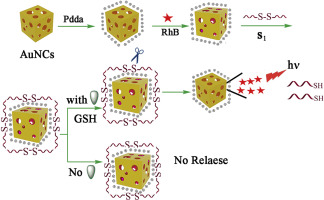当前位置:
X-MOL 学术
›
Anal. Chim. Acta
›
论文详情
Our official English website, www.x-mol.net, welcomes your
feedback! (Note: you will need to create a separate account there.)
An ultra-sensitive fluorescent “Turn On” biosensor for glutathione and its application in living cells
Analytica Chimica Acta ( IF 5.7 ) Pub Date : 2018-01-01 , DOI: 10.1016/j.aca.2017.10.024 Wei Wang , Xiaoshan Hou , Xin Li , Chen Chen , Xiliang Luo
Analytica Chimica Acta ( IF 5.7 ) Pub Date : 2018-01-01 , DOI: 10.1016/j.aca.2017.10.024 Wei Wang , Xiaoshan Hou , Xin Li , Chen Chen , Xiliang Luo

|
In this work, an effective controlled-release biosensor based on Au nanocages (AuNCs) capped with disulfide-containing DNA molecular gates was developed for ultra-sensitive and highly selective detection of glutathione (GSH). Oligonucleotides containing the S-S bonds were assembled on the surface of the AuNCs by means of electrostatic interactions in order to inhibit the release of fluorescent molecules such as Rhodamine B (RhB) loaded by AuNCs. In the presence of GSH, due to the specific cleavage of S-S bonds in disulfide-containing single-stranded DNAs (ssDNAs) as well as their subsequent departure from the surface of AuNCs, the pores could be opened, and then the dye molecules would be released from AuNCs. The concentration of GSH ranged from 1.0 × 10-12 to 6.0 × 10-10 M could be detected. The developed amplification strategy based on the controlled-release of fluorescent molecules reached an extraordinary sensitivity of GSH. A detection limit of as low as 4.8 × 10-13 M with an excellent selectivity toward GSH could be achieved. The results of fluorescence microscopy imaging of GSH in living cells indicate that the fabricated system is an efficient controlled-release biosensor in response to intracellular target molecules and predict its potential use for in situ molecular imaging in living systems.
中文翻译:

一种用于谷胱甘肽的超灵敏荧光“开启”生物传感器及其在活细胞中的应用
在这项工作中,开发了一种基于 Au 纳米笼 (AuNCs) 的有效控释生物传感器,该传感器覆盖了含二硫化物的 DNA 分子门,用于谷胱甘肽 (GSH) 的超灵敏和高选择性检测。含有 SS 键的寡核苷酸通过静电相互作用组装在 AuNCs 的表面,以抑制 AuNCs 加载的荧光分子如罗丹明 B (RhB) 的释放。在 GSH 存在下,由于含二硫键的单链 DNA (ssDNAs) 中 SS 键的特异性裂解以及随后它们从 AuNCs 表面的脱离,可以打开孔,然后染料分子将从 AuNC 中释放。可检测到的 GSH 浓度范围为 1.0 × 10-12 至 6.0 × 10-10 M。开发的基于荧光分子控制释放的扩增策略达到了对 GSH 的非凡灵敏度。可以实现低至 4.8 × 10-13 M 的检测限,并且对 GSH 具有出色的选择性。活细胞中 GSH 的荧光显微镜成像结果表明,所制造的系统是一种有效的控释生物传感器,可响应细胞内靶分子,并预测其在活体系统中进行原位分子成像的潜在用途。
更新日期:2018-01-01
中文翻译:

一种用于谷胱甘肽的超灵敏荧光“开启”生物传感器及其在活细胞中的应用
在这项工作中,开发了一种基于 Au 纳米笼 (AuNCs) 的有效控释生物传感器,该传感器覆盖了含二硫化物的 DNA 分子门,用于谷胱甘肽 (GSH) 的超灵敏和高选择性检测。含有 SS 键的寡核苷酸通过静电相互作用组装在 AuNCs 的表面,以抑制 AuNCs 加载的荧光分子如罗丹明 B (RhB) 的释放。在 GSH 存在下,由于含二硫键的单链 DNA (ssDNAs) 中 SS 键的特异性裂解以及随后它们从 AuNCs 表面的脱离,可以打开孔,然后染料分子将从 AuNC 中释放。可检测到的 GSH 浓度范围为 1.0 × 10-12 至 6.0 × 10-10 M。开发的基于荧光分子控制释放的扩增策略达到了对 GSH 的非凡灵敏度。可以实现低至 4.8 × 10-13 M 的检测限,并且对 GSH 具有出色的选择性。活细胞中 GSH 的荧光显微镜成像结果表明,所制造的系统是一种有效的控释生物传感器,可响应细胞内靶分子,并预测其在活体系统中进行原位分子成像的潜在用途。











































 京公网安备 11010802027423号
京公网安备 11010802027423号